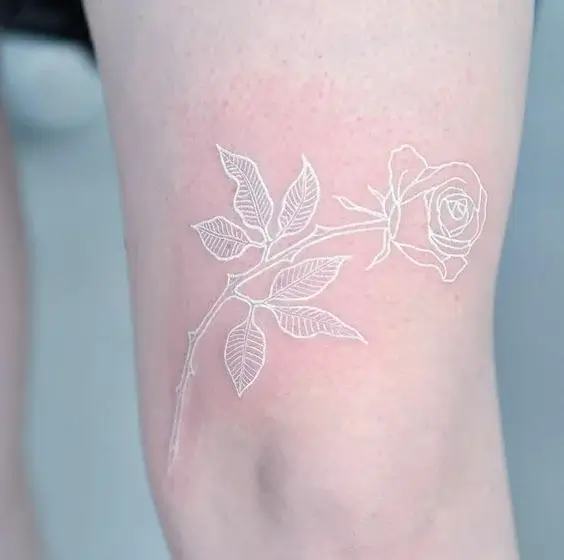Most people use tattoos to express their feelings. The human body is an excellent canvas for this, with different ink colors available to make unique and attractive tattoos. Getting white ink tattoos has become increasingly famous because they appear delicate and unique. However, tattoo lovers are often shocked, “Why does white ink hurt?” This article discovers every aspect of white ink tattoos, the reasons behind the discomfort, and the level of pain experienced by tattoo artists. You also get all the information about tattoos, so don’t forget to follow Tattoorecover.com.
Know the Pain Factor in Tattooing
With the help of needles, tattoo artists inject ink into your skin. All of these things are involved in tattooing, a process that naturally reasons for some stage of discomfort. In addition to pain tolerance, skin sensitivity, and the part of the body that is tattooed, the amount of pain is different for everyone. However, white ink tattoos feel to trigger extra concerns. So we are to discuss all the serious concerns for white ink tattoos, don’t skip this.

Certain Things of White Ink Causing Discomfort
The inks used in white tattoos tend to be thicker than tattoo inks used in cultural tattoos. Because of their smooth and beautiful appearance. During the tattooing process, this thickness can result in a more severe feeling. The complex nature of white ink designs is also part of the extended sessions, making the recipient feel more uncomfortable overall. So there are different types of things that are painful in White Ink tattooing.
Factors Influencing Pain Perception
There is a complex interaction between physical and psychological factors that determine how one perceives pain. It is possible for anxiety, fear, or excitement to exacerbate the sensation of pain when tattooing. You must know all of these factors that can help you people mentally for the process and manage anticipations regarding the pain connected with white ink tattoos. You must check out these articles for more info.
- Full Lip Tattoo Healing Process
- How Long Does A Finger Tattoo Take To Heal
- When Will A Finger Tattoo Start To Blur And Fade?
Why do Tattoo Artists Not Use White Ink?
White ink use is often a source of hesitation among tattoo artists, despite wanting to make unique and private artwork. White ink tattoos present many challenges and limitations, which will be connected with hesitation. One important thing that you must read is, ” When you wash your part of the body where you have a white ink tattoo, once the tattoo recovers or heals, it will look more like a scar.” When the years pass, the color will vanish, causing the scar-like appearance.

Challenges and Limitations of White Ink
The longevity and visibility of white ink are unpopular and unforeseeable. Tattoo artists don’t forget the possibility of fading and discoloration over time when dedicated to delivering top-quality work. The results of variations in skin tones and textures are a huge challenge to achieve consistent results with white ink.
Technical Difficulties for Artistsk
You need a professional tattoo artist to use white ink. Artists must be careful and skillful when they use them. Professional artists must navigate a delicate balance between ensuring the ink is suitably placed on the skin and avoiding overworking the area. There are also technical difficulties that are contributing to tattoo artists’ hesitation to participate in this practice.
Alternatives Considered by Tattoo Artists
Because white ink poses a number of challenges, Tattoo artists often discover a replacement to achieve similar visual effects. There are some options for fine shading with cultural black or colored inks to make a smooth appearance. While other white highlights are added technically. All of these replacements allow the artist to maintain unique flexibility while reducing the risk connected with pure white ink.
What Color Tattoo Hurts the Most?
Tattoo lovers often think about which type of color causes the most pain, beyond the challenges of white ink. One thing that is very important is that the pain of the tattoo experience is different for everyone. There are specific factors involved in the overall satisfaction experienced during the process. But here are some colors that are mostly painful. Purple color tattoo which is extremely painful and the yellow color tattoo is not painful. The pain of the tattoo also depends on the tattoo placement.
Comparing Pain Levels Among Tattoo Ink Colors
It depends on your thinking, but according to science, tattoo color and ink do not directly impact pain intensity. Different factors play an essential role in the intensity of the pain, including tattoo design location, chosen body part, and permanent tattoo. Everyone’s pain and patience levels are also different. Colors packed densely and with vibrant colors may cause discomfort because they require more needle passes.
Can Skin Reject White Ink?
Do you think to get white ink tattoos, then you should consider the possibility that your skin might reject the ink? Everyone needs to be aware of the possibility of ink rejection before making a decision regarding white ink designs. In some cases, there can be, itching, swelling, and even oozing of the skin around the tattooed area. In this condition, your skin may reject the white ink, leaving you without a tattoo in that area.
Discover the Possibility of Ink Rejection
Ink rejection occurs when the body’s immune system recognizes tattoo ink as a foreign substance and tries to terminate it. White ink is not risk-free, although it is more common in specific colors. Various factors can involve ink rejection, including pre-existing skin conditions, allergic reactions, and poor tattooing techniques. Must now the fun facts about tattoo, and also the 10 Tips For Safely Working Out After a Tattoo.
Risks Associated with White Ink Tattoos
Additionally to the common risks of tattooing,white ink tattoos also come with certain risks. A white ink’s thick consistency increases its irritant and inflammatory properties.When considering a white ink tattoo, those with sensitive skin or a history of allergic reactions should be careful and discuss with a dermatologist first.
Tips for Stop Ink Rejection
So all of tattoo lover should pick a trusted tattoo artist with a hygienic studio to reduce the risk of ink rejection. Making sure you have done comprehensive research, choosing the right aftercare, and opting for a small test patch with white ink before dedicating to a bigger design can help identify possible allergic reactions early on.
Why Do People Hate White Tattoo Ink?
Despite the growing popularity of white ink tattoos, some people hate white tattoo ink. But everyone has their own choice. I am here to share my experience choice is yours. It is necessary to debunk myths, consider cultural and aesthetic factors, and address common criticisms to comprehend this sentiment. The main reason for this is the white in the tattoo does not appear on the skin quite easily so maybe that is the reason to hate it.
Common Criticisms and Misconceptions
Everyone has its own reason, but there so many reasons why people dislike white ink tattoos, including issues with visibility, longevity, and vibrancy. Negative sentiment toward white ink tattoos is exacerbated by the perception that they fade quickly or become barely noticeable over time. You need to know the factors that influence the success of white ink tattoos in order to dispel these misconceptions.
Summary
In this amazing and famous tattoo world, the charm of white ink designs brings both reflection and excitement. We’ve traveled through the complex tapestry of body art, unraveling the mysterious reasons for uncomfortable white ink tattoos and getting to know tattoo artists’ reservations about these ethereal designs. We conclude that tattoo design needs an appreciation of the elegant balance between complexity and burstiness. In order for a tattoo to be timeless and meaningful, it must combine specific details, creativity, and contextual importance.


7 thoughts on “Why Does White Ink Hurt In 2024”